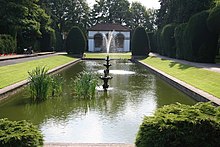Ayscoughfee Hall





Ayscoughfee Hall /ˈæskəˌfiː hɔːl/ ⓘ is a grade I listed building and modest associated parkland in central Spalding, Lincolnshire, England,[1] and is a landmark on the fen tour.
History
The
The Hall was reputed to have belonged to the Ayscough (Askew, Ainscough) family in the early part of the 16th century – Fee referring to the Knight's Fee or living from the property. Early records name the house as Ayscough Fee Hall. A grant of land at Spalding was made to Sir William Ayscough (1490–1541) by Henry VIII.[3] E. H. Gooch writes about "Ayscoughfee Hall" in his book "The History of Spalding", 1940.[2][5]
In the seventeenth century, the Hall passed into the Johnson family. The most notable Johnson was the second
Maurice Johnson was a good friend of the more famous local antiquarian William Stukeley.[3]Museum and civic amenity
When the last occupants, the family of Charles Foster Bonner, left in 1896, the Hall and Gardens were bought[by whom?] on behalf of the people of Spalding as a memorial of Queen Victoria's Diamond Jubilee, and was handed over[by whom?] to the town "free of debt" on 9 August 1902 in celebration of the coronation of King Edward VII and Queen Alexandra.[1][2] Now a museum and civic amenity, the house was also used as a primary school for a number of years during the 20th century.[2]
Some of the features of the 5-acre (20,000 m2) gardens were reputedly laid out by
Other features include a bowling green, tennis courts, aviary and aWith
-
Stained glass
-
Kitchen exhibition
References
- ^ a b c Historic England (25 January 2012). "Ayscoughee Hall (Grade I) (1359532)". National Heritage List for England. Retrieved 9 March 2012.
- ^ a b c d e f g h i j "Ayscoughee Hall (leaflet)" (PDF). SouTh Holland District Council. 2012. Archived from the original (PDF) on 5 December 2014. Retrieved 9 March 2012.
- ^ Archaeological Project Services. Retrieved 9 March 2013.
- ^ South Holland District Council. 2012. Archived from the originalon 6 February 2013. Retrieved 9 March 2013.
- ^ Gooch, E.H. (1940). the History of Spalding.
- ^ The oldest being the Oxford Ashmolean, "web history of society". Archived from the original on 14 November 2011.
- ^ "Spalding Gentlemen's Society".
- ^ Historic England. "War memorial (Grade II) (1064002)". National Heritage List for England. Retrieved 9 March 2012.
- ^ Historic England. "Park and Gardens (Grade II) (1000969)". National Heritage List for England. Retrieved 9 March 2012.
- ^ Article by Anderson and Glenn, the Project Managers and Conservation Architects for the restoration: http://www.andersonandglenn.com/index.php?page=test2
- The Buildings of England.
- Pursglove, Rosylyn (October 1994). "History of Ayscoughee Hall" (PDF). South Holland Museum Service. Archived from the original (PDF) on 3 March 2016. Retrieved 9 March 2013. Has an extensive and useful Bibliography
- Glenn, John (July 2000). "Historical appraisal of the pleasure gardens" (PDF). Anderson and Glenn, Boston. Retrieved 9 March 2013.
- Penn, Kenneth (January 2008). "An Archaeological Desk-based Survey of Ayscoughfee Hall Gardens" (PDF). NAU archaeology. Retrieved 9 March 2013.[permanent dead link]


